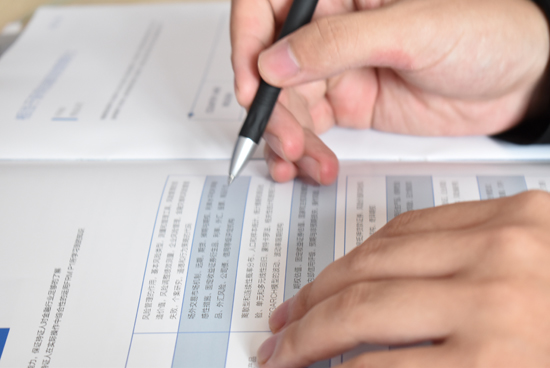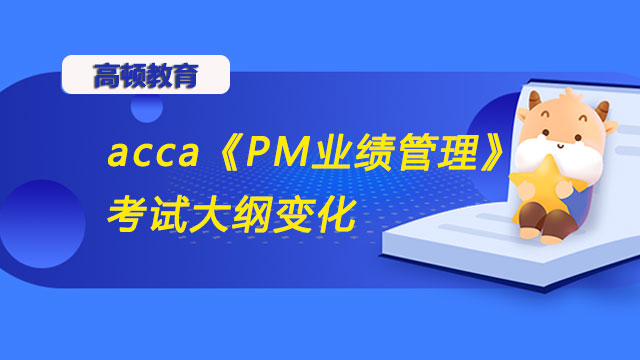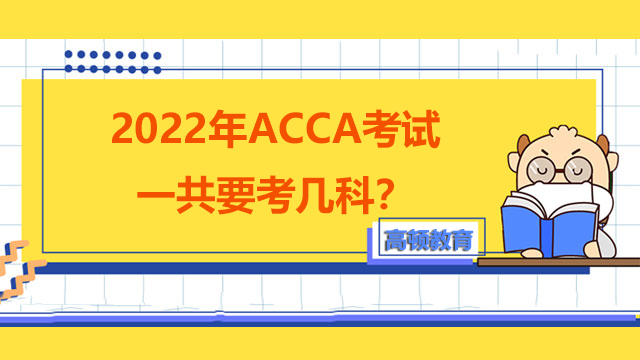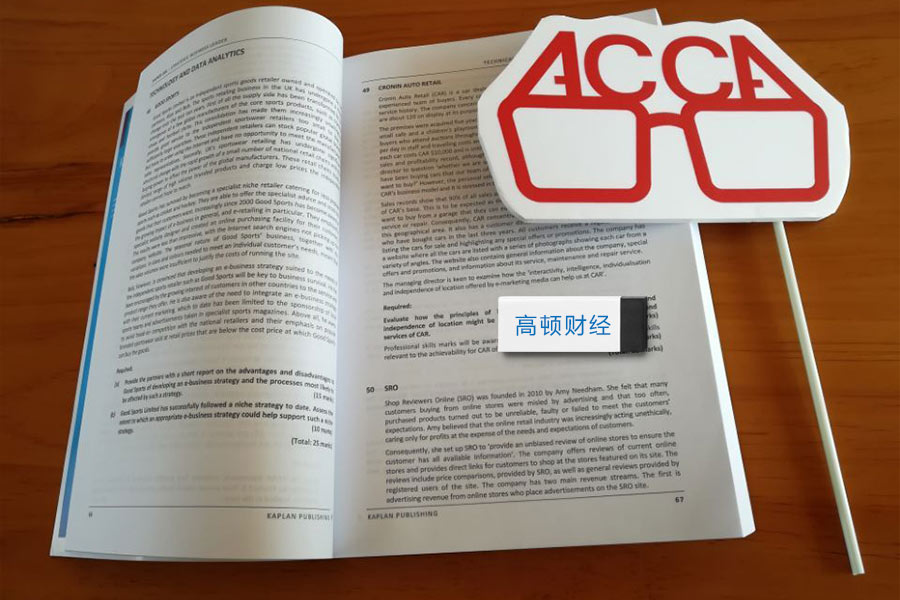2015ACCA F6税务考试大纲
来源:
高顿网校
2015-03-25
? ACCA 2015 All rights reserved.
1
Taxation (UK) (F6)
Exams in the financial year 1 April 2015 to 31 March 2016
This syllabus and study guide is designed to help
with planning study and to provide detailed
information on what could be assessed in
any examination session.
THE STRUCTURE OF THE SYLLABUS AND
STUDY GUIDE
Relational diagram of paper with other papers
This diagram shows direct and indirect links
between this paper and other papers preceding or
following it. Some papers are directly underpinned by other papers such as Advanced Performance
Management by Performance Management. These
links are shown as solid line arrows. Other papers
only have indirect relationships with each other
such as links existing between the accounting and
auditing papers. The links between these are shown
as dotted line arrows. This diagram indicates where
you are expected to have underpinning knowledge
and where it would be useful to review previous
learning before undertaking study.
Overall aim of the syllabus
This explains briefly the overall objective of the
paper and indicates in the broadest sense the
capabilities to be developed within the paper.
Main capabilities
This paper’s aim is broken down into several main
capabilities which divide the syllabus and study
guide into discrete sections.
Relational diagram of the main capabilities
This diagram illustrates the flows and links between
the main capabilities (sections) of the syllabus and
should be used as an aid to planning teaching and
learning in a structured way.
Syllabus rationale
This is a narrative explaining how the syllabus is
structured and how the main capabilities are linked.
The rationale also explains in further detail what the
examination intends to assess and why.
Detailed syllabus
This shows the breakdown of the main capabilities
(sections) of the syllabus into subject areas. This is
the blueprint for the detailed study guide.
Approach to examining the syllabus
This section briefly explains the structure of the
examination and how it is assessed.
Study Guide
This is the main document that students, tuition
providers and publishers should use as the basis of
their studies, instruction and materials.
Examinations will be based on the detail of the
study guide which comprehensively identifies what
could be assessed in any examination session.
The study guide is a precise reflection and
breakdown of the syllabus. It is divided into sections
based on the main capabilities identified in the
syllabus. These sections are divided into subject
areas which relate to the sub-capabilities included
in the detailed syllabus. Subject areas are broken
down into sub-headings which describe the detailed
outcomes that could be assessed in examinations.
These outcomes are described using verbs
indicating what exams may require students to
demonstrate, and the broad intellectual level at
which these may need to be demonstrated
(*see intellectual levels below)。
INTELLECTUAL LEVELS
The syllabus is designed to progressively broaden
and deepen the knowledge, skills and professional
values demonstrated by the student on their way
through the qualification.
The specific capabilities within the detailed
syllabuses and study guides are assessed at one of
three intellectual or cognitive levels:
LevelⅠ: Knowledge and comprehension
LevelⅡ: Application and analysis ? ACCA 2015 All rights reserved.
2
LevelⅢ: Synthesis and evaluation
Very broadly, these intellectual levels relate to the
three cognitive levels at which the Knowledge
module, the Skills module and the Professional level
are assessed.
Each subject area in the detailed study guide
included in this document is given a 1, 2, or
3 superscript, denoting intellectual level, marked at
the end of each relevant line. This gives an
indication of the intellectual depth at which an area
could be assessed within the examination. However,
while level 1 broadly equates with the Knowledge
module, level 2 equates to the Skills module and
level 3 to the Professional level, some lower level
skills can continue to be assessed as the student
progresses through each module and level. This
reflects that at each stage of study there will be a
requirement to broaden, as well as deepen
capabilities. It is also possible that occasionally
some higher level capabilities may be assessed at
lower levels.
LEARNING HOURS AND EDUCATION RECOGNITION
The ACCA qualification does not prescribe or
recommend any particular number of learning hours
for examinations because study and learning
patterns and styles vary greatly between people and
organisations. This also recognises the wide
diversity of personal, professional and educational
circumstances in which ACCA students find
themselves.
As a member of the International Federation of Accountants, ACCA seeks to enhance the education recognition of its qualification on both national and international education frameworks, and with educational authorities and partners globally. In doing so, ACCA aims to ensure that its qualifications are recognized and valued by governments, regulatory authorities and employers across all sectors. To this end, ACCA qualifications are currently recognized on the education frameworks in several countries. Please refer to your national education framework regulator for further information.
Each syllabus contains between 23 and 35 main
subject area headings depending on the nature of
the subject and how these areas have been broken
down.
GUIDE TO EXAM STRUCTURE
The structure of examinations varies within and
between modules and levels.
The Fundamentals level examinations contain
100% compulsory questions to encourage
candidates to study across the breadth of each
syllabus.
The Knowledge module is assessed by equivalent
two-hour paper based and computer based
examinations.
The Skills module examinations F5-F9 are all paper
based three-hour papers containing a mix of
objective and longer type questions. The Corporate
and Business Law (F4) paper is a two-hour
computer based objective test examination which is
also available as a paper based version from the
December 2014 examination sitting.
The Professional level papers are all three-hour
paper based examinations, all containing two
sections. Section A is compulsory, but there will be
some choice offered in Section B.
For all three hour examination papers, ACCA has introduced 15 minutes reading and planning time.
This additional time is allowed at the beginning of each three-hour examination to allow candidates to read the questions and to begin planning their answers before they start writing in their answer books. This time should be used to ensure that all the information and exam requirements are properly read and understood.
During reading and planning time candidates may only annotate their question paper. They may not write anything in their answer booklets until told to do so by the invigilator.
The Essentials module papers all have a Section A
containing a major case study question with all
requirements totalling 50 marks relating to this
case. Section B gives students a choice of two from
three 25 mark questions.
Section A of both the P4 and P5 Options papers contain one 50 mark compulsory question, and ? ACCA 2015 All rights reserved.
3
Section B will offer a choice of two from three questions each worth 25 marks each.
Section A of each of the P6 and P7 Options papers contains 60 compulsory marks from two questions; question 1 attracting 35 marks, and question 2 attracting 25 marks. Section B of both these Options papers will offer a choice of two from three questions, with each question attracting 20 marks.
All Professional level exams contain four professional marks.
The pass mark for all ACCA Qualification examination papers is 50%.
GUIDE TO EXAMINATION ASSESSMENT
ACCA reserves the right to examine anything
contained within the study guide at any examination
session. This includes knowledge, techniques,
principles, theories, and concepts as specified.
For the tax papers, ACCA will publish examinable
documents, or tax rates and allowances tables, once a year to indicate exactly what legislation could potentially be assessed within identified examination sessions. These should be read in conjunction with the information below.
For UK tax papers, examinations falling within the financial year 1 April to 31 March will examine the Finance Act which was passed in the previous July. I.e. Exams falling in the period 1 April 2015 to 31 March 2016 will examine the Finance Act 2014.
For SGP tax papers, examinations falling within the year 1 April to 31 March will be based on legislation passed before the previous 30 September. I.e. examinations falling in the year 1 April 2015 to 31 March 2016 will be based on legislation passed by 30 September 2014.
For MYS tax papers, examinations falling within the year 1 October to 30 September will be based on legislation passed before the previous 31 March. I.e. examinations falling in the year 1 October 2014 to 30 September 2015 will be based on legislation passed before the previous 31 March 2014.
For CYP tax papers, June and December examinations will be based on regulation or legislation published in the Official Gazette of the Republic of Cyprus (“the Gazette”) on or before 30 September. I.e. June and December 2015 papers will be based on regulation or legislation published in the Official Gazette of the Republic of Cyprus (“the Gazette”) on or before 30 September 2014.
For CZE tax papers, December and June examinations will be based on legislation passed before the previous 31 May. I.e. December 2014 and June 15 papers will be based on legislation in force at 31 May 2014
For VNM tax papers, June and December examinations will be based on legislation passed before the previous 31 December. I.e. June and December 2015 papers will be based on legislation passed by 31 December 2014.
Tax papers for the following variants:
BWA, CHN, HUN, HKG, IRL, LSO, MWI, MLA, POL, PKN, ROM, RUS, ZAF, ZWE.
The June and December examinations will be based on legislation passed before the previous 30 September. I.e. June and December 2015 papers will be based on legislation passed by 30 September 2014. ? ACCA 2015 All rights reserved.
4
Syllabus
ATX (P6)
TX (F6)
AIM
To develop knowledge and skills relating to the tax system as applicable to individuals, single companies, and groups of companies.
MAIN CAPABILITIES
On successful completion of this paper candidates should be able to:
A Explain the operation and scope of the tax system and the obligations of tax payer and/or their agents and the implications of non-compliance
B Explain and compute the income tax liabilities of individuals and the effect of national insurance contributions (NIC) on employees, employers and the self-employed
C Explain and compute the chargeable gains arising on individuals
D Explain and compute the inheritance tax liabilities of individuals
E Explain and compute the corporation tax liabilities of individual companies and groups of companies
F Explain and compute the effects of value added tax on incorporated and unincorporated businesses
RELATIONAL DIAGRAM OF MAIN CAPABILITIES
The UK tax Ta (A)
The UK tax system and its administration (A)
Corporation tax
liabilities (E)
Income tax and NIC
liabilities (B)
Inheritance tax (D)
Chargeable gains for individuals (C)
VAT (F) ? ACCA 2015 All rights reserved.
5
RATIONALE
The syllabus for Paper F6, Taxation, introduces candidates to the subject of taxation and provides the core knowledge of the underlying principles and major technical areas of taxation as they affect the activities of individuals and businesses.
Candidates are introduced to the rationale behind - and the functions of - the tax system. The syllabus then considers the separate taxes that an accountant would need to have a detailed knowledge of, such as income tax from
self-employment, employment and investments, the corporation tax liability of individual companies and groups of companies, the national insurance contribution liabilities of both employed and self employed persons, the value added tax liability of businesses, the chargeable gains arising on disposals of investments by both individuals and companies, and the inheritance tax liabilities arising on chargeable lifetime transfers and on death.
Having covered the core areas of the basic taxes, candidates should be able to compute tax liabilities, explain the basis of their calculations, apply tax planning techniques for individuals and companies and identify the compliance issues for each major tax through a variety of business and personal scenarios and situations.
DETAILED SYLLABUS
A. The UK tax system and its administration
1. The overall function and purpose of taxation in a modern economy
2. Principal sources of revenue law and practice
3. The systems for self-assessment and the making of returns
4. The time limits for the submission of information, claims and payment of tax, including payments on account
5. The procedures relating to compliance checks, appeals and disputes
6. Penalties for non-compliance
B. Income tax and NIC liabilities
1. The scope of income tax
2. Income from employment
3. Income from self-employment
4. Property and investment income
5. The comprehensive computation of taxable income and income tax liability
6. National insurance contributions for employed and self-employed persons
7. The use of exemptions and reliefs in deferring and minimising income tax liabilities
C. Chargeable gains for individuals
1. The scope of the taxation of capital gains
2. The basic principles of computing gains and losses
3. Gains and losses on the disposal of movable and immovable property
4. Gains and losses on the disposal of shares and securities
5. The computation of capital gains tax
6. The use of exemptions and reliefs in deferring and minimising tax liabilities arising on the disposal of capital assets
D. Inheritance tax
1. The basic principles of computing transfers of value
2. The liabilities arising on chargeable lifetime transfers and on the death of an individual
3. The use of exemptions in deferring and minimising inheritance tax liabilities
4. Payment of inheritance tax ? ACCA 2015 All rights reserved.
6
E. Corporation tax liabilities
1. The scope of corporation tax
2. Taxable total profits
3. Chargeable gains for companies
4. The comprehensive computation of corporation tax liability
5. The effect of a group corporate structure for corporation tax purposes
6. The use of exemptions and reliefs in deferring and minimising corporation tax liabilities
F. Value added tax
1. The VAT registration requirements
2. The computation of VAT liabilities
3. The effect of special schemes
APPROACH TO EXAMINING THE SYLLABUS
The syllabus is assessed by a three-hour paper-based examination.
The paper will be predominantly computational and
all questions are compulsory.
Section A of the exam comprises 15 multiple choice questions of 2 marks each.
Section B of the exam comprises four 10 mark questions and two 15 mark questions.
The two 15 mark questions will focus on income tax (syllabus area B) and corporation tax (syllabus area E)。
The section A questions and the other questions in section B can cover any areas of the syllabus. ? ACCA 2015 All rights reserved.
7
Study Guide
A THE UK TAX SYSTEM AND ITS ADMINISTRATION
1. The overall function and purpose of taxation in a modern economy
a) Describe the purpose (economic, social etc) of taxation in a modern economy.[1]
b) Explain the difference between direct and indirect taxation.[2]
c) Identify the different types of capital and revenue tax.[1]
2. Principal sources of revenue law and practice
a) Describe the overall structure of the UK tax system.[1]
b) State the different sources of revenue law.[1]
c) Describe the organisation HM Revenue & Customs (HMRC) and its terms of reference. [1]
d) Explain the difference between tax avoidance and tax evasion, and the purposes of the General Anti-Abuse Rule (GAAR)。[1]
e) Appreciate the interaction of the UK tax system with that of other tax jurisdictions.[2]
f) Appreciate the need for double taxation agreements.[2]
g) Explain the need for an ethical and professional approach.[2]
Excluded topics
? Specific anti-avoidance legislation.
3. The systems for self-assessment and the making of returns
a) Explain and apply the features of the self- assessment system as it applies to individuals.[2]
b) Explain and apply the features of the self- assessment system as it applies to companies, including the use of iXBRL.[2]
4. The time limits for the submission of information, claims and payment of tax, including payments on account
a) Recognise the time limits that apply to the filing of returns and the making of claims.[2]
b) Recognise the due dates for the payment of tax under the self-assessment system, and compute payments on account and balancing payments/repayments for individuals.[2]
c) Explain how large companies are required to account for corporation tax on a quarterly basis and compute the quarterly instalment payments.[2]
d) List the information and records that taxpayers need to retain for tax purposes.[1]
Excluded topics
? The payment of CGT by annual instalments.
5. The procedures relating to compliance checks, appeals and disputes
a) Explain the circumstances in which HM Revenue & Customs can make a compliance check into a self-assessment tax return.[2]
b) Explain the procedures for dealing with appeals and First and Upper Tier Tribunals.[2]
Excluded topics
? Information powers.
? Pre-return compliance checks.
? Detailed procedures on the carrying out and completion of a compliance check.
6. Penalties for non-compliance
a) Calculate late payment interest and state the penalties that can be charged.[2] ? ACCA 2015 All rights reserved.
8
B INCOME TAX AND NIC LIABILITIES
1. The scope of income tax
a) Explain how the residence of an individual is determined.[1]
Excluded topics
? The split year treatment where a person comes to the UK or leaves the UK.
? Foreign income, non-residents and double taxation relief.
? Income from trusts and settlements.
2. Income from employment
a) Recognise the factors that determine whether an engagement is treated as employment or self-employment.[2]
b) Recognise the basis of assessment for employment income.[2]
c) Recognise the income assessable.[2]
d) Recognise the allowable deductions, including travelling expenses.[2]
e) Discuss the use of the statutory approved mileage allowances.[2]
f) Explain the PAYE system.[1]
g) Identify P11D employees.[1]
h) Explain and compute the amount of benefits assessable.[2]
i) Explain the purpose of a dispensation from HM Revenue & Customs.[2]
Excluded topics
? The calculation of a car benefit where emission figures are not available.
? The exemption for zero emission company motor cars.
? The exemption where an employer pays for medical treatment.
? Share and share option incentive schemes for employees.
? Payments on the termination of employment, and other lump sums received by employees.
? Real time reporting late filing penalties.
3. Income from self-employment
a) Recognise the basis of assessment for self- employment income.[2]
b) Describe and apply the badges of trade.[2]
c) Recognise the expenditure that is allowable in calculating the tax-adjusted trading profit.[2]
d) Explain and compute the assessable profits using the cash basis for small businesses.[2]
e) Recognise the relief which can be obtained for pre-trading expenditure.[2]
f) Compute the assessable profits on commencement and on cessation.[2]
g) Recognise the factors that will influence the choice of accounting date.[2]
h) Capital allowances
i) Define plant and machinery for capital allowances purposes.[1]
ii) Compute writing down allowances, first-year allowances and the annual investment allowance.[2]
iii) Compute capital allowances for motor cars.[2]
iv) Compute balancing allowances and balancing charges.[2]
v) Recognise the treatment of short life assets.[2]
vi) Recognise the treatment of assets included in the special rate pool.[2]
i) Relief for trading losses
i) Understand how trading losses can be carried forward.[2] ? ACCA 2015 All rights reserved.
9
ii) Understand how trading losses can be claimed against total income and chargeable gains, and the restriction that can apply.[2]
iii) Explain and compute the relief for trading
losses in the early years of a trade.[1]
iv) Explain and compute terminal loss relief.[1]
v) Recognise the factors that will influence the choice of loss relief claim.[2]
j) Partnerships and limited liability partnerships
i) Explain and compute how a partnership is assessed to tax.[2]
ii) Explain and compute the assessable profits for each partner following a change in the profit sharing ratio.[2]
iii) Explain and compute the assessable profits for each partner following a change in the membership of the partnership.[2]
iv) Describe the alternative loss relief claims that are available to partners.[1]
Excluded topics
? Change of accounting date.
? The 100% allowance for expenditure on renovating business premises in disadvantaged areas, flats above shops and water technologies.
? Capital allowances for industrial buildings, agricultural buildings, patents, scientific research and know how.
? CO2 emission thresholds for capital allowances for motor cars prior to 6 April 2013.
? Apportionment in order to determine the amount of annual investment allowance where a period of account spans 6 April 2014.
? Enterprise zones.
? Investment income of a partnership.
? The allocation of notional profits and losses for a partnership.
? Farmers averaging of profits.
? The averaging of profits for authors and creative artists.
? Loss relief following the incorporation of a business.
? Loss relief for shares in unquoted trading companies.
? The loss relief restriction that applies to the partners of a limited liability partnership.
4. Property and investment income
a) Compute property business profits.[2]
b) Explain the treatment of furnished holiday lettings.[1]
c) Understand rent-a-room relief.[1]
d) Compute the amount assessable when a premium is received for the grant of a short lease.[2]
e) Understand how relief for a property business loss is given.[2]
f) Compute the tax payable on savings and dividends income.[2]
g) Recognise the treatment of new individual savings accounts (NISAs) and other tax exempt investments.[1]
Excluded topics
? The deduction for expenditure by landlords on energy-saving items.
? Premiums for granting subleases.
? The ISA investment rules and limits that applied prior to 1 July 2014.
? Junior ISAs.
5. The comprehensive computation of taxable income and income tax liability
a) Prepare a basic income tax computation involving different types of income.[2] ? ACCA 2015 All rights reserved.
10
b) Calculate the amount of personal allowance available generally, and for people born before 6 April 1948.[2]
c) Compute the amount of income tax payable.[2]
d) Understand the treatment of interest paid for a
qualifying purpose.[2]
e) Understand the treatment of gift aid donations and charitable giving.[1]
f) Explain and compute the child benefit tax charge.[1]
g) Understand the treatment of property owned jointly by a married couple, or by a couple in a civil partnership.[1]
Excluded topics
? The blind person’s allowance and the married couple’s allowance.
? Tax credits.
? Maintenance payments.
? The income of minor children.
6. National insurance contributions for employed and self-employed persons
a) Explain and compute national insurance contributions payable:
i) Class 1 and 1A NIC.[2]
ii) Class 2 and 4 NIC. [2]
b) Understand the annual employment allowance.[2]
Excluded topics
? The calculation of directors’ national insurance on a month by month basis.
? Contracted out contributions.
? The offset of trading losses against non-trading income.
7. The use of exemptions and reliefs in deferring and minimising income tax liabilities
a) Explain and compute the relief given for contributions to personal pension schemes, and to occupational pension schemes.[2]
b) Understand how a married couple or a couple in a civil partnership can minimise their tax liabilities.[2]
Excluded topics
? The conditions that must be met in order for a pension scheme to obtain approval from HM Revenue & Customs.
? The enterprise investment scheme and the seed enterprise investment scheme.
? Venture capital trusts.
? Tax reduction scheme for gifts of pre-eminent objects.
C CHARGEABLE GAINS FOR INDIVIDUALS
1. The scope of the taxation of capital gains
a) Describe the scope of capital gains tax.[2]
b) Recognise those assets which are exempt.[1]
Excluded topics
? Assets situated overseas and double taxation relief.
? Partnership capital gains.
2. The basic principles of computing gains and losses
a) Compute and explain the treatment of capital gains.[2]
b) Compute and explain the treatment of capital losses [2]
c) Understand the treatment of transfers between a husband and wife or between a couple in a civil partnership.[2]
d) Understand the amount of allowable expenditure for a part disposal.[2] ? ACCA 2015 All rights reserved.
11
e) Recognise the treatment where an asset is damaged, lost or destroyed, and the implications of receiving insurance proceeds and reinvesting such proceeds.[2]
Excluded topics
? Small part disposals of land, and small capital sums received where an asset is damaged.
? Losses in the year of death.
? Relief for losses incurred on loans made to traders.
? Negligible value claims.
3. Gains and losses on the disposal of movable and immovable property
a) Identify when chattels and wasting assets are exempt.[1]
b) Compute the chargeable gain when a chattel or a wasting asset is disposed of.[2]
c) Calculate the chargeable gain when a principal private residence is disposed of.[2]
Excluded topics
? The disposal of leases and the creation of sub-leases.
4. Gains and losses on the disposal of shares and securities
a) Recognise the value of quoted shares where they are disposed of by way of a gift.[2]
b) Explain and apply the identification rules as they apply to individuals including the same day and 30 day matching rules.[2]
c) Explain and apply the pooling provisions.[2]
d) Explain and apply the treatment of bonus issues, rights issues, takeovers and reorganisations.[2]
e) Identify the exemption available for gilt-edged securities and qualifying corporate bonds.[1]
Excluded topics
? The exemption for employee shareholders.
? The small part disposal rules applicable to rights issues, takeovers and reorganisations.
? Gilt-edged securities and qualifying corporate bonds other than the fact that they are exempt.
5. The computation of capital gains tax
a) Compute the amount of capital gains tax payable.[2]
b) Explain and apply entrepreneurs’ relief. [2]
Excluded topics
? Entrepreneurs’ relief for associated disposals.
6. The use of exemptions and reliefs in deferring and minimising tax liabilities arising on the disposal of capital assets
a) Explain and apply capital gains tax reliefs: (i) rollover relief.[2]
(ii) holdover relief for the gift of business assets.[2]
Excluded topics
? Incorporation relief.
? Reinvestment relief.
D INHERITANCE TAX
1. The basic principles of computing transfers of value
a) Identify the persons chargeable.[2]
b) Understand and apply the meaning of transfer of value, chargeable transfer and potentially exempt transfer.[2] ? ACCA 2015 All rights reserved.
12
c) Demonstrate the diminution in value principle.[2]
d) Demonstrate the seven year accumulation principle taking into account changes in the level of the nil rate band.[2]
Excluded topics
? Pre 18 March 1986 lifetime transfers.
? Transfers of value by close companies.
? Domicile, deemed domicile, and non-UK domiciled individuals.
? Trusts.
? Excluded property.
? Related property.
? The tax implications of the location of assets.
? Gifts with reservation of benefit.
? Associated operations.
2. The liabilities arising on chargeable lifetime transfers and on the death of an individual
a) Understand the tax implications of lifetime transfers and compute the relevant liabilities.[2]
b) Understand and compute the tax liability on a death estate.[2]
c) Understand and apply the transfer of any unused nil rate band between spouses.[2]
Excluded topics
? Specific rules for the valuation of assets (values will be provided)。
? Business property relief.
? Agricultural relief.
? Relief for the fall in value of lifetime gifts.
? Quick succession relief.
? Double tax relief.
? Variation of wills and disclaimers of legacies.
? Grossing up on death.
? Post mortem reliefs.
? Double charges legislation.
? The reduced rate of inheritance tax payable on death when a proportion of a person’s estate is bequeathed to charity.
3. The use of exemptions in deferring and minimising inheritance tax liabilities
a) Understand and apply the following exemptions:
i) small gifts exemption[2]
ii) annual exemption[2]
iii) normal expenditure out of income[2]
iv) gifts in consideration of marriage[2]
v) gifts between spouses.[2]
Excluded topics
? Gifts to charities.
? Gifts to political parties.
? Gifts for national purposes.
4. Payment of inheritance tax
a) Identify who is responsible for the payment of inheritance tax and the due date for payment of inheritance tax.[2]
Excluded topics
? Administration of inheritance tax other than listed above.
? The instalment option for the payment of tax.
? Interest and penalties.
? ACCA 2015 All rights reserved.
13
E CORPORATION TAX LIABILITIES
1. The scope of corporation tax
a) Define the terms ‘period of account’, ‘accounting period’, and ‘financial year’。[1]
b) Recognise when an accounting period starts and when an accounting period finishes.[1]
c) Explain how the residence of a company is determined.[2]
Excluded topics
? Investment companies.
? Close companies.
? Companies in receivership or liquidation.
? Reorganisations.
? The purchase by a company of its own shares.
? Personal service companies.
2. Taxable total profits
a) Recognise the expenditure that is allowable in calculating the tax-adjusted trading profit.[2]
b) Recognise the relief which can be obtained for pre-trading expenditure.[1]
c) Compute capital allowances (as for income tax)。[2]
d) Compute property business profits and understand how relief for a property business loss is given.[2]
e) Understand how trading losses can be carried forward.[2]
f) Understand how trading losses can be claimed against income of the current or previous accounting periods.[2]
g) Recognise the factors that will influence the choice of loss relief claim.[2]
h) Recognise and apply the treatment of interest paid and received under the loan relationship rules.[1]
i) Recognise and apply the treatment of qualifying charitable donations.[2]
j) Compute taxable total profits.[2]
Excluded topics
? Research and development expenditure.
? Non-trading deficits on loan relationships.
? Relief for intangible assets.
? Patent box.
3 Chargeable gains for companies
a) Compute and explain the treatment of chargeable gains.[2]
b) Explain and compute the indexation allowance available.[2]
c) Explain and compute the treatment of capital losses.[1]
d) Understand the treatment of disposals of shares by companies and apply the identification rules including the same day and nine day matching rules.[2]
e) Explain and apply the pooling provisions.[2]
f) Explain and apply the treatment of bonus issues, rights issues, takeovers and reorganisations.[2]
g) Explain and apply rollover relief.[2]
Excluded topics
? A detailed question on the pooling provisions as they apply to limited companies.
? Substantial shareholdings.
? ACCA 2015 All rights reserved.
14
4. The comprehensive computation of corporation tax liability
a) Compute the corporation tax liability and apply marginal relief.[2]
b) Recognise the implications of receiving franked investment income.[2]
5. The effect of a group corporate structure for corporation tax purposes
a) Define an associated company and recognise the effect of having associated companies for corporation tax purposes.[2]
b) Define a 75% group, and recognise the reliefs that are available to members of such a group.[2]
c) Define a 75% chargeable gains group, and recognise the reliefs that are available to members of such a group.[2]
Excluded topics
? Relief for trading losses incurred by an overseas subsidiary.
? Consortia.
? Pre-entry gains and losses.
? The anti-avoidance provisions where arrangements exist for a company to leave a group.
? The tax charge that applies where a company leaves a group within six years of receiving an asset by way of a no gain/no loss transfer.
? Overseas aspects of corporation tax.
? Transfer pricing
6. The use of exemptions and reliefs in deferring and minimising corporation tax liabilities:
The use of such exemptions and reliefs is implicit within all of the above sections 1 to 5 of part E of the syllabus, concerning corporation tax.
F VALUE ADDED TAX
1. The VAT registration requirements
a) Recognise the circumstances in which a person must register or deregister for VAT (compulsory) and when a person may register or deregister for VAT (voluntary)。[2]
b) Recognise the circumstances in which pre- registration input VAT can be recovered.[2]
c) Explain the conditions that must be met for two or more companies to be treated as a group for VAT purposes, and the consequences of being so treated.[1]
2. The computation of VAT liabilities
a) Understand how VAT is accounted for and administered.[2]
b) Recognise the tax point when goods or services are supplied.[2]
c) List the information that must be given on a VAT invoice.[1]
d) Explain and apply the principles regarding the valuation of supplies.[2]
e) Recognise the principal zero rated and exempt supplies [1]
f) Recognise the circumstances in which input VAT is non-deductible.[2]
g) Recognise the relief that is available for impairment losses on trade debts.[2]
h) Understand when the default surcharge, a penalty for an incorrect VAT return, and default interest will be applied.[1]
i) Understand the treatment of imports, exports and trade within the European Union.[2]
Excluded topics
? VAT periods where there is a change of VAT rate.
? ACCA 2015 All rights reserved.
15
? Partial exemption.
? In respect of property and land: leases, do-it-yourself builders, and a landlord's option to tax.
? Penalties apart from those listed in the study guide.
3. The effect of special schemes
a) Understand the operation of, and when it will be advantageous to use, the VAT special schemes:
i) cash accounting scheme.[2]
ii) annual accounting scheme.[2]
iii) flat rate scheme. [2]
Excluded topics
? The second-hand goods scheme.
? The capital goods scheme.
? The special schemes for retailers.
? ACCA 2015 All rights reserved.
16
SUMMARY OF CHANGES TO F6 (UK)
ACCA periodically reviews it qualification syllabuses so that they fully meet the needs of stakeholders such as employers, students, regulatory and advisory bodies and learning providers.
Some of the syllabus areas have been reordered
as shown in Table 1 below:
Table 1 - Reordering within F6 (UK) Section and subject area Syllabus content
Reordering of syllabus areas The syllabus areas have been reordered so that syllabus area A covers the UK tax system and its administration, B covers income tax and NIC liabilities, C covers chargeable gains for individuals, D covers inheritance tax, E covers corporation tax (including chargeable gains) and F covers VAT.
Enlarged syllabus area A Syllabus area H (the obligations of the taxpayer and/or their agents) has been combined with syllabus area A to create an enlarged syllabus area A (the UK tax system and its administration)。
National insurance National insurance has been moved and is now included in syllabus area B (Income tax and NIC liabilities)
E3 Chargeable gains for companies Chargeable gains have been split between individuals (syllabus area C) and companies (syllabus area E3 Corporation tax)
高顿网校温馨提示: 通过ACCA考试实属不易,首先要有执着的精神,其次是不断勤奋的学习,高顿网校为大家提供ACCA题库免费做题,希望助大家一臂之力,查看详情》
| ACCA网络课程 | 课程专业名称 | 讲师 | 试听 |
 85%的人正在学习该课程 85%的人正在学习该课程 | ACCA 全维度网课体验课程 实景课堂与独立录制 覆盖所有知识点,根据学习计划推进学习进度 | 高顿名师 |  |
 70%的人正在学习该课程 70%的人正在学习该课程 | ACCA网课全科卡(8.2折) 为零基础刚开始学习ACCA的学员特别定制 | 高顿名师 |  |
精彩推荐:
版权声明:本条内容自发布之日起,有效期为一个月。凡本网站注明“来源高顿教育”或“来源高顿网校”或“来源高顿”的所有作品,均为本网站合法拥有版权的作品,未经本网站授权,任何媒体、网站、个人不得转载、链接、转帖或以其他方式使用。
经本网站合法授权的,应在授权范围内使用,且使用时必须注明“来源高顿教育”或“来源高顿网校”或“来源高顿”,并不得对作品中出现的“高顿”字样进行删减、替换等。违反上述声明者,本网站将依法追究其法律责任。
本网站的部分资料转载自互联网,均尽力标明作者和出处。本网站转载的目的在于传递更多信息,并不意味着赞同其观点或证实其描述,本网站不对其真实性负责。
如您认为本网站刊载作品涉及版权等问题,请与本网站联系(邮箱fawu@gaodun.com,电话:021-31587497),本网站核实确认后会尽快予以处理。
点一下领资料
【整理版】ACCA各科目历年真题
真题高频考点,刷题全靠这份资料
下载合集
acca全科学习思维导图
梳理核心考点,一图看懂全部章节
下载合集
2023年acca考纲解析
覆盖科目重难点,备考按照计划走
下载合集
acca备考 热门问题解答
- acca考试怎么搭配科目?
-
建议优先选择相关联的科目进行搭配报考,这样可以提高备考效率,减轻备考压力,1、F1-F4:为随时机考科目,难度较低,这里可以自行随意选择考试顺序。2、F5-F9:如果你的工作的和财务会计或者审计有关、或者你比较擅长财务和审计的话,推荐先考F7和F8。你可以选择一起考ACCA考试科目F7和F8或者先考F7(8)再考F8(7),这就要取决你一次想考几门。3、P阶段:选修科目中,建议企业首选AFM!第二部分科目进行选择,如果AA和SBR掌握学生更好,可以通过选择AAA,如果SBL掌握的好,可以自己选择APM。
- acca一共几门几年考完?
-
acca一共有15门考试科目,其中有必修科目和选修科目,考生需要考完13门科目才能拿下证书。
- acca一年考几次?
-
acca一年有4次考试,分别是3月、6月、9月和12月,分季机考科目是采取的这类四个考季的模式,而随时机考则是没有这方面的时间规定限制,可以随报随考。
- acca的含金量如何?
-
ACCA证书的含金量是比较高的,从就业、能力提升、全球认可等角度来说,都是比较有优势的证书,其含金量主要表现在以下几个方面:1、国际化,认可度高;2、岗位多,就业前景好;3、缺口大,人才激励。
严选名师 全流程服务
其他人还搜了
热门推荐
-
长春ACCA培训课程,高顿ACCA推荐吗? 2023-06-19
-
【考试重点】acca2023年9月SBL变化详解,速进了解! 2023-06-19
-
acca《PM业绩管理》考试大纲变化,2023年9月起变动情况一览! 2023-04-26
-
2023年6月acca考试哪些科目考纲有变化?赶快来看! 2023-04-25
-
ACCA2023年考试重点介绍,新手看过来! 2023-03-29
-
9月acca考试考纲变了吗?这些科目变动你要了解! 2023-03-10
-
acca考纲每次变化大吗?2023年9月起变动0%-12%! 2023-03-10
-
ACCA科目名称英文一览 2022-05-23
-
ACCA都考什么内容? 2022-05-20
-
ACCA课程内容介绍 2022-05-12
-
2022年ACCA考试一共要考几科? 2022-05-11
-
ACCA的考试内容都有什么? 2022-05-10
-
ACCA官网操作 | 如何鉴别自己是FIA还是ACCA&考试报名退考流程 2021-06-30
-
2020年最新ACCA考试大纲哪里找? 2020-03-04
-
2014年12月ACCA考试改动方向及难度变化,资阳考生必看! 2019-01-04
-
2014年12月ACCA考试改动方向及难度变化,资阳考生必看! 2019-01-04
-
2018年ACCA考试新旧考纲变化详解 2019-01-02
-
12月ACCA考试前瞻:2017年9月ACCA F7考试分析 2017-11-21
-
ACCA考试F8考试大纲变化解析 2017-04-19
-
ACCA考试F7考纲变化分析 2017-01-04
-
acca福建厦门考点i831在哪里 2016-12-19
-
拉萨有没有比较好的ACCA培训机构? 2016-06-29
-
石嘴山有没有比较好的ACCA培训机构? 2016-06-29
-
嘉峪关有没有比较好的ACCA培训机构? 2016-06-29
-
吐鲁番有没有比较好的ACCA培训机构? 2016-06-29
-
武夷山有没有比较好的ACCA培训机构? 2016-06-29
-
保山有没有比较好的ACCA培训机构? 2016-06-22
-
果洛有没有比较好的ACCA培训机构? 2016-06-22
-
临夏有没有比较好的ACCA培训机构? 2016-06-22
-
喀什有没有比较好的ACCA培训机构? 2016-06-22
 更多服务
更多服务





























